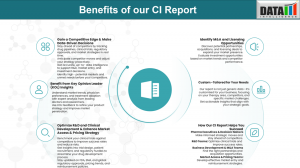Next-Generation Therapies Reshape Gaucher’s Disease as Gene Therapy Advances Challenge Enzyme Replacement Dominance
Gene therapies challenge ERT dominance in Gaucher’s disease as new data reveals strategic insights, key players, and future treatment opportunities.
Download Free CI Sample Report: https://www.datamintelligence.com/strategic-insights/gauchers-disease-gd
Gaucher’s Disease: Overview and Burden
Gaucher’s disease is a rare, inherited autosomal recessive condition caused by mutations in the GBA1 gene, leading to deficient glucocerebrosidase (GCase) enzyme activity. This enzyme deficiency results in the accumulation of glucocerebroside in cells and organs, leading to symptoms including hepatosplenomegaly, anemia, bone crises, and in some forms, neurological decline. With a global incidence of 1 in 40,000 to 100,000 live births, GD remains the most prevalent lysosomal storage disorder worldwide.
Current Standard of Care and Market Players
The current therapeutic landscape is anchored by FDA-approved treatments across two main modalities: ERTs and SRTs. Sanofi leads the market with Cerezyme (imiglucerase), an established ERT, and Cerdelga (eliglustat), the only first-line oral SRT. Other ERT options include Takeda’s VPRIV (velaglucerase alfa) and Pfizer’s Elelyso (taliglucerase alfa), each targeting non-neuronopathic Type 1 GD.
Johnson & Johnson’s Zavesca (miglustat), once an early oral alternative, is now a backup option due to tolerability concerns and CNS-related side effects. While these therapies control systemic symptoms, they fall short in addressing neurological manifestations, which remain the highest unmet need in neuronopathic Gaucher’s disease (Types 2 and 3).
Pipeline Analysis and Emerging Therapies
The pipeline for Gaucher’s disease is rich with innovation, particularly in the realm of gene therapy. Companies such as Spur Therapeutics (FLT201) and Eli Lilly/Prevail (PR001) are developing adeno-associated virus (AAV)-based gene therapies that offer potential one-time treatments with CNS penetration—a critical advantage for neuronopathic forms.
FLT201 stands out with AAV delivery, CNS reach, and potential curative impact, while PR001 is tied to Parkinson’s-related GBA mutations and uses an AAV9 vector. Despite promising early data, these approaches face challenges including long-term safety, scalability, pricing, and regulatory hurdles.
Competitive Landscape and Market Positioning
The competitive benchmarking matrix within the report evaluates leading drugs across five strategic parameters: mechanism of action, clinical stage, delivery mode, target population, and differentiation levers. While legacy ERTs remain dominant due to proven efficacy and global reimbursement, they are hampered by infusion burden, high costs, and lack of CNS penetration.
Oral SRTs like Cerdelga offer convenience but are genotype-dependent and limited in severe cases. In contrast, gene therapies offer an ambitious yet realistic opportunity to disrupt the market, especially if they can show durable CNS benefit, lower treatment frequency, and long-term cost-effectiveness.
Target Opportunity Profile (TOP): Defining the Future Winners
The report presents a Target Opportunity Profile (TOP) that outlines what emerging GD therapies must deliver to surpass current standards. To outperform existing ERTs and SRTs, new candidates must demonstrate:
- Superior or equal safety with minimal immunogenicity
- Broader efficacy, especially for neuronopathic GD
- Oral or one-time delivery options
- Long-lasting effects (5 years or more for gene therapies)
- CNS penetration capability
- Cost-effectiveness and global accessibility
The ideal therapy will not only offer hematologic and visceral symptom control but also address neurological decline and pediatric treatment gaps—areas underserved by current options.
Market Segmentation and Strategic Outlook
The report segments the market into three key modalities: ERT, SRT, and gene therapy. While ERT remains the commercial backbone due to institutional familiarity and established reimbursement, gene therapy is poised to capture future share, especially for high-burden and neuronopathic patients. Emerging markets like China, where CANbridge Pharma is pursuing regional ERT approval, are also gaining strategic attention.
Key Players to Watch
- Sanofi: Market leader in both ERT and SRT spaces with Cerezyme and Cerdelga
- Takeda: Strong ERT contender with VPRIV
- Pfizer: Offers cost-effective ERT (Elelyso), mainly in LATAM and Israel
- Spur Therapeutics and Eli Lilly: Driving innovation in gene therapy
- CANbridge Pharma: Expanding access in Asia-Pacific markets
Conclusion
Gaucher’s disease is on the cusp of a therapeutic revolution. As gene and mRNA therapies emerge, stakeholders—whether investors, regulators, or clinicians—must rethink traditional paradigms. For new entrants to succeed, they must go beyond matching current therapies: they must address long-standing unmet needs, especially neurological involvement and treatment burden.
Read our Related CI Reports:
1. Polycythemia Vera | Competitive Intelligence
2. Hepatocellular Carcinoma | Competitive Intelligence
Sai Kiran
DataM Intelligence 4market Research LLP
877-441-4866
email us here
Visit us on social media:
LinkedIn
X
Legal Disclaimer:
EIN Presswire provides this news content "as is" without warranty of any kind. We do not accept any responsibility or liability for the accuracy, content, images, videos, licenses, completeness, legality, or reliability of the information contained in this article. If you have any complaints or copyright issues related to this article, kindly contact the author above.
Streamlined Diagnostics for Workshops: leagend Introduces MS300 OBD II Scanner for Efficient Engine Fault Management
NBC12 Segment Features Johnathan H. Miller on Summer Home Staging Strategies in Richmond
UN Human Rights-Supported High Note Global Prize Awarded to the Song 'We Believe in Hope' on International Day of Hope
Więcej ważnych informacji
 Jedynka Newserii
Jedynka Newserii

 Jedynka Newserii
Jedynka Newserii

Handel

Polskie MŚP otrzymają większe wsparcie w ekspansji międzynarodowej. To cel nowej inicjatywy sześciu instytucji
Firmy z sektora małych i średnich przedsiębiorstw otrzymają kompleksowe wsparcie na potrzeby zwiększania konkurencyjności na arenie międzynarodowej. Taki jest cel wspólnej inicjatywy instytucji zrzeszonych w Grupie PFR pod szyldem Team Poland. Obejmuje ona zarówno wsparcie kapitałowe, w postaci gwarancji, pożyczek czy ubezpieczenia, jak i doradztwo oraz wsparcie promocyjne i informacyjne, dzięki czemu mikro-, małym i średnim firmom łatwiej będzie podjąć decyzję o ekspansji zagranicznej. Pierwszy projekt dotyczy wsparcia dla firm zainteresowanych uczestnictwem w odbudowie Ukrainy.
Bankowość
RPP zgodna co do potrzeby obniżania stóp procentowych. Trwają dyskusje dotyczące tempa tych decyzji

W lipcu Rada Polityki Pieniężnej po raz drugi w tym roku obniżyła stopy procentowe, określając swój ruch mianem dostosowania. W kolejnych miesiącach można oczekiwać kolejnych obniżek, ale ich tempo i termin będą zależeć od efektów dotychczasowych decyzji i wzrostu płac. Docelowo główna stopa procentowa ma wynosić 3,5 proc. Te okoliczności sprzyjają kredytobiorcom.
Handel
Umowa z krajami Mercosur coraz bliżej. W. Buda: Polska nie wykorzystała swojej prezydencji do jej zablokowania

– Polska podczas prezydencji w Radzie UE nie wykorzystała szansy na obronę swoich interesów w sprawie umowy z krajami Mercosur – ocenia europoseł PiS Waldemar Buda. W jego ocenie polski rząd, mimo sprzeciwu wobec zapisów umowy, nie zbudował w UE sojuszy niezbędnych do jej odrzucenia. Porozumienie o wolnym handlu spotyka się przede wszystkim z protestami europejskich rolników, którzy obawiają się zalania wspólnego rynku tańszą żywnością z krajów Ameryki Południowej. Według europosła wszystko może się rozegrać w najbliższych tygodniach.
Partner serwisu
Szkolenia

Akademia Newserii
Akademia Newserii to projekt, w ramach którego najlepsi polscy dziennikarze biznesowi, giełdowi oraz lifestylowi, a także szkoleniowcy z wieloletnim doświadczeniem dzielą się swoją wiedzą nt. pracy z mediami.




![Część środków z Planu Społeczno-Klimatycznego trafi na walkę z ubóstwem transportowym. Organizacje branżowe apelują o zmianę priorytetowych projektów [DEPESZA]](https://www.newseria.pl/files/1097841585/rower3,w_85,_small.jpg)




.gif)

 |
| |
| |
|